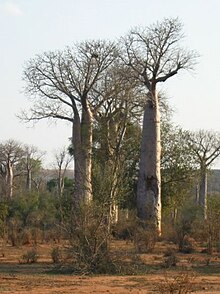Adansonia za is a species of baobab in the genus Adansonia of the family Malvaceae (previously included in the Bombacaceae). It was originally named in French as anadzahé.[3] Common names in Malagasy include bojy, boringy, bozy, bozybe, ringy, and za,[4] the last of which gives the plant its specific epithet.[5] Eight Adansonia species are recognized, with six endemic to Madagascar. Adansonia za is the most widespread of the Madagascar endemics.[1]
| Adansonia za | |
|---|---|

| |
| Scientific classification | |
| Kingdom: | Plantae |
| Clade: | Tracheophytes |
| Clade: | Angiosperms |
| Clade: | Eudicots |
| Clade: | Rosids |
| Order: | Malvales |
| Family: | Malvaceae |
| Genus: | Adansonia |
| Species: | A. za
|
| Binomial name | |
| Adansonia za | |
| Synonyms | |
Description edit
Adansonia za is a large thick-stemmed (pachycaul) deciduous tree, about 10–40 metres (33–131 ft) tall and about 6 metres (20 ft) in diameter. The trunk and branches have a brownish-rose colored hue. The tree is widest at the base, narrowing noticeably towards the top of the tree.
Leaves edit
Leaves are palmately lobed with 5 to 8 lobes per leaf.[6] They are 5–10 centimetres (2.0–3.9 in) long and 1.5–2.5 centimetres (0.59–0.98 in) wide, but often bigger in trees in the northern part of the range, where the leaves can be up to 20 centimetres (7.9 in) long.[6] The leaf margin is entire (without teeth).
Flowers edit
The flower buds are long green cylinders which can resemble oversized beans and could be mistaken for a fruit. Flowers open with or soon after the leaves emerge at the beginning of the wet season.[6] The bud opens with the curling back of the outside layer of the flower bud, revealing yellow and red petals with long, yellowish stamens. The corolla is 15–20 centimetres (5.9–7.9 in) long and 1.2–1.5 centimetres (0.47–0.59 in) wide. Petals are 10–20 centimetres (3.9–7.9 in) long and 1.2–1.5 centimetres (0.47–0.59 in) wide. The flowers are musty-sweet scented. Flowering period extends from November to February. Flowers are usually pollinated by moths of the family Sphingidae including Coelonia solani, Coelonia brevis and Coelonia mauritii.[6]
Fruits edit
Fruits are usually ovoid and 10–30 centimetres (3.9–11.8 in) long by 06–16 centimetres (2.4–6.3 in) wide.[6] They have a blackish, tough, thick outer shell (pericarp). They contain kidney-shaped, laterally-flattened seeds. The seeds have an oil content of 11 percent. In southern populations, the fruits have a markedly thickened peduncle, but this feature is less prominent in northern populations.[6]
Distribution edit
Adansonia za is endemic to southern and north-western Madagascar. Populations are severely fragmented and numbers are declining due to habitat loss and logging.[1]
Habitat edit
This plant grows in arid scrublands, in deciduous forests, savannah and in Madagascar spiny forests. It prefers sunny areas and well drained soils, at an elevation up to 800 metres (2,600 ft) above sea level. It is the dominant tree in some of the southern deciduous forests, becoming less common to the north.[6]
Largest tree edit
Possibly the largest tree of this species (by circumference) grows near Reakaly village north-west from Ampanihy. The circumference of its trunk is approximately 23 metres (75 ft).[7][8]
Uses edit
The fruit pulp and roots of seedlings as well as the seeds are edible. Seeds contain 11% oil. Wood may be fed to cattle during droughts and the trunk can be hollowed out to store water. The bark fibre can be use for cloth or rope and the flowers may be used to sooth sore throats.[9]
Gallery edit
-
Plants of Adansonia za
-
Leaning Adansonia za
-
Adansonia za', southern Madagascar
-
The "Baobab Amoureux", near Avenue of the Baobabs in Menabe, Madagascar
References edit
- ^ a b c Letsara, R.; Faramalala, M.; Razafindrahaja, V.; Faranirina, L. (2019). "Adansonia za". IUCN Red List of Threatened Species. 2019: e.T37680A64367122. doi:10.2305/IUCN.UK.2019-3.RLTS.T37680A64367122.en. Retrieved 17 November 2021.
- ^ Baillon, Henri Ernest (7 May 1890). "Sur les Baobabs de Madagascar". Bulletin Mensuel de la Société Linnéenne de Paris (in French). 2 (406): 844–846. OCLC 5069130. Retrieved 14 March 2018.
Nous nommerons cette espèce Adansonia za.
- ^ de Flacourt, Étienne (1661). "CHAPITRE XIV Du pays des Mahafalles Houlouve Siveh & Vouronheoc". Histoire de la grande isle Madagascar: avec une relation de ce qui s'est passe es annees 1655, 1656 et 1657 non encor veue par la premiere Impression (in French). Pierre l'Amy. p. 41. OCLC 718580508. Retrieved 14 March 2018.
- ^ Bradt, Hilary (March 2011). "3 Natural History". Madagascar. Bradt Travel Guides (10 ed.). Bradt Travel Guides. p. 44. ISBN 9781841623412. OCLC 861680238. Retrieved 14 March 2018.
- ^ Wickens, Gerald E.; Lowe, Pat (2 March 2008). "1 Historical Background". The Baobabs: Pachycauls of Africa, Madagascar and Australia. Springer Science & Business Media. p. 24. ISBN 9781402064319. OCLC 239278146. Retrieved 14 March 2018.
- ^ a b c d e f g Baum, D.A., 1995, A Systematic Revision of Adansonia (Bombacaceae). Annals of the Missouri Botanical Garden , 1995, Vol. 82, No. 3 (1995), pp. 440-471
- ^ "Reakaly Baobab (Ampanihy Baobab)". Wondermondo. 30 July 2014.
- ^ "Baobab (Adansonia za)". davesgarden.com. 11 April 2006.
Image of tree
- ^ Ambrose-Oji, B. & Mughogho, N., 2007. Adansonia za Baill. [Internet] Record from PROTA4U. van der Vossen, H.A.M. & Mkamilo, G.S. (Editors). PROTA (Plant Resources of Tropical Africa / Ressources végétales de l'Afrique tropicale), Wageningen, Netherlands. <http://www.prota4u.org/>. Accessed 10 April 2022.
Sources edit
- Baum, David A. (1995). "The Comparative Pollination and Floral Biology of Baobabs (Adansonia- Bombacaceae)". Annals of the Missouri Botanical Garden. 82 (2): 322–348. doi:10.2307/2399883. JSTOR 2399883.
- Baum, David A. (1995). "A Systematic Revision of Adansonia (Bombacaceae)". Annals of the Missouri Botanical Garden. 82 (3): 440–471. doi:10.2307/2399893. JSTOR 2399893.
